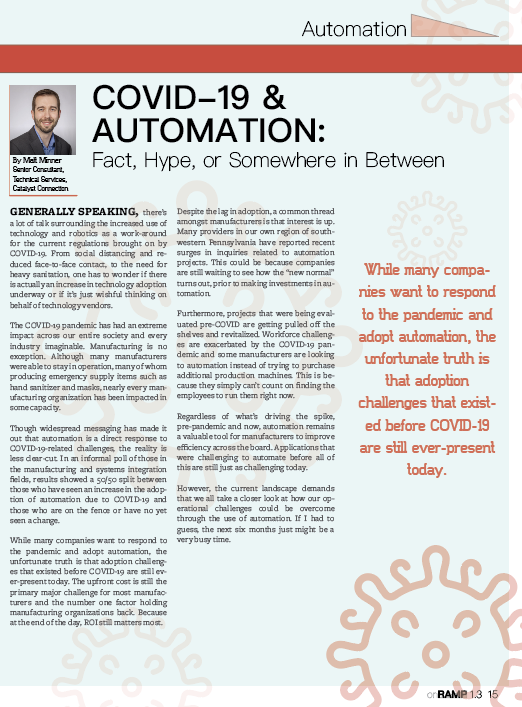COVID-19 & Automation: Fact, Hype, or Somewhere in Between
By Matt Minner Senior Consultant, Technical Services, Catalyst Connection
 Generally speaking, there’s a lot of talk surrounding the increased use of technology and robotics as a work-around for the current regulations brought on by COVID-19. From social distancing and reduced face-to-face contact, to the need for heavy sanitation, one has to wonder if there is actually an increase in technology adoption underway or if it’s just wishful thinking on behalf of technology vendors.
Generally speaking, there’s a lot of talk surrounding the increased use of technology and robotics as a work-around for the current regulations brought on by COVID-19. From social distancing and reduced face-to-face contact, to the need for heavy sanitation, one has to wonder if there is actually an increase in technology adoption underway or if it’s just wishful thinking on behalf of technology vendors.
The COVID-19 pandemic has had an extreme impact across our entire society and every industry imaginable. Manufacturing is no exception. Although many manufacturers were able to stay in operation, many of whom producing emergency supply items such as hand sanitizer and masks, nearly every manufacturing organization has been impacted in some capacity.
Though widespread messaging has made it out that automation is a direct response to COVID-19-related challenges, the reality is less clear-cut. In an informal poll of those in the manufacturing and systems integration fields, results showed a 50/50 split between those who have seen an increase in the adoption of automation due to COVID-19 and those who are on the fence or have no yet seen a change.
While many companies want to respond to the pandemic and adopt automation, the unfortunate truth is that adoption challenges that existed before COVID-19 are still ever-present today. The upfront cost is still the primary major challenge for most manufacturers and the number one factor holding manufacturing organizations back. Because at the end of the day, ROI still matters most.
Despite the lag in adoption, a common thread amongst manufacturers is that interest is up. Many providers in our own region of southwestern Pennsylvania have reported recent surges in inquiries related to automation projects. This could be because companies are still waiting to see how the “new normal” turns out, prior to making investments in automation.
Furthermore, projects that were being evaluated pre-COVID are getting pulled off the shelves and revitalized. Workforce challenges are exacerbated by the COVID-19 pandemic and some manufacturers are looking to automation instead of trying to purchase additional production machines. This is because they simply can’t count on finding the employees to run them right now.
Regardless of what’s driving the spike, pre-pandemic and now, automation remains a valuable tool for manufacturers to improve efficiency across the board. Applications that were challenging to automate before all of this are still just as challenging today.
However, the current landscape demands that we all take a closer look at how our operational challenges could be overcome through the use of automation. If I had to guess, the next six months just might be a very busy time.
Read the entire issue of OnRamp Magazine: